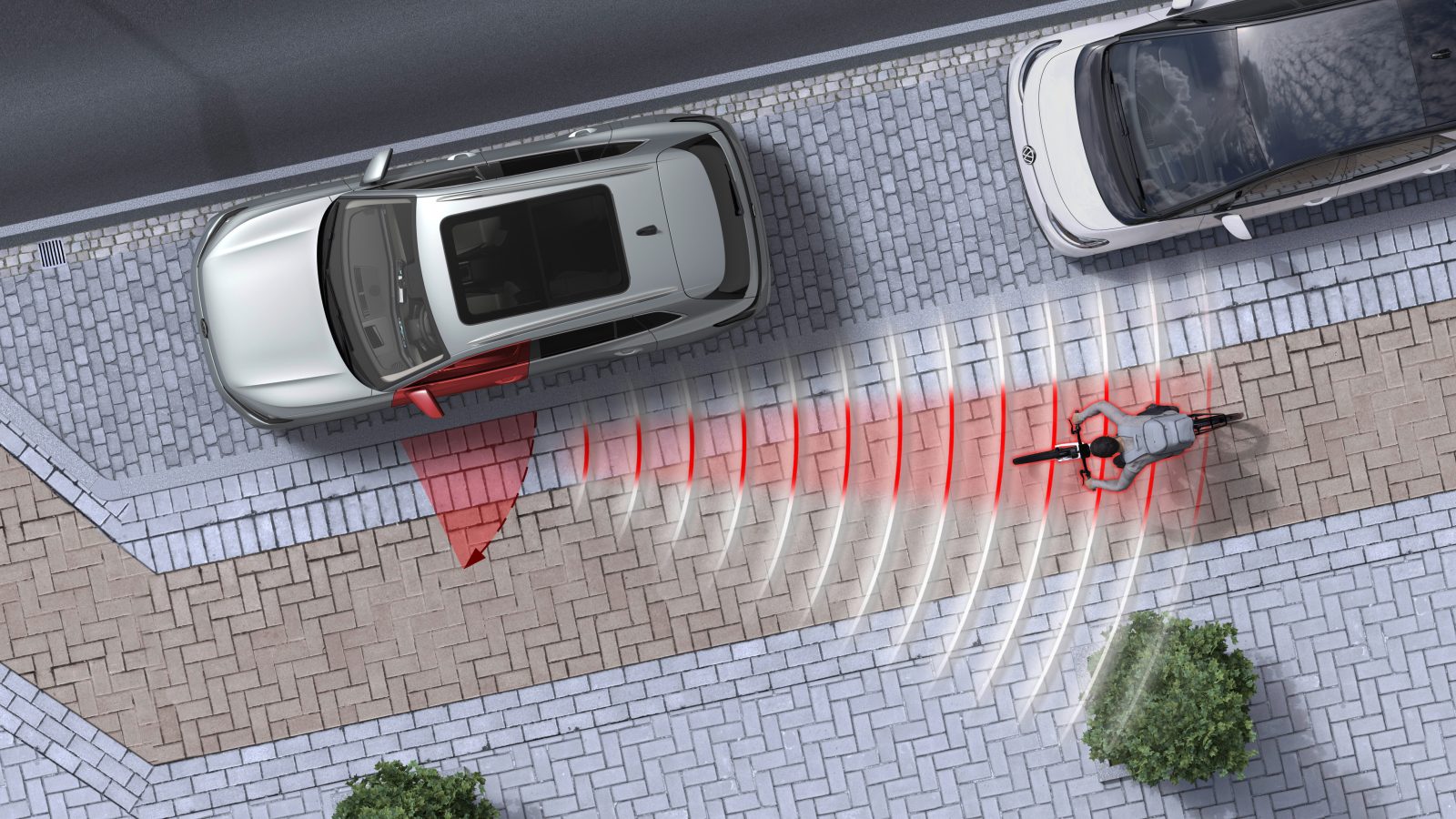Getting doored is every cyclist’s fear, but next-gen car tech aims to curb it


Getting doored – when a car door unexpectedly flings open and you crash into it – is one of the most underestimated dangers to cyclists. While some cars have exit warning systems to protect cyclists, next-gen cars from Volkswagen and Ford attempts to push that technology a bit further.
Getting doored is dangerous business for cyclists, especially in dense urban areas where cyclists ride next to parked cars, or use bike lanes adjacent to parked cars. As a decades-long cyclist in large cities, I can attest that, while you can attempt to avoid this, such as keeping a buffer zone between your bike and car doors and being alert to passenger behavior in parked or stopped cars, there is always the potential for surprise that could send you crashing into a door – a kid flinging open a door, someone stepping out in a rush, getting pushed out of your buffer zone by a passing car and then a passenger opens their door. Cities are one thing, but I also cycle frequently outside of cities, where people are even more unaware.
For a while automakers have been devising exit warning systems to alert drivers to objects moving near the car, with Mercedes-Benz and Volvo, among others, coming out with their own systems. Ford and Volkswagen are the newest entrants, with Volkswagen’s ID.7 version even blocking the door from opening if a cyclist is whizzing by three minutes after the car has been turned off. At their most fundamental, the systems all work essentially the same, using sensors on the rear of the car to check for oncoming objects (cyclists, mopeds, or even runners or other pedestrians) and then flash a warning light and/or sound an alarm as you attempt to open your door.
For Ford’s exit warning system, an LED indicator on the side mirror lights up as a warning – passengers can see a warning on the dashboard in addition to hear a warning sound. The system warns door openers of an object traveling at 4 mph (or 7 km/h) or faster, which is similar to Mercedes-Benz’s system. The system was first announced this summer, but Ford is now introducing it on delivery vans first, the Transit Custom and Tourneo Custom, first in Europe. Upcoming models of the Explorer and Mustang will also get it, starting in Europe.
Volkswagen’s latest generation tech will debut similar technology for its upcoming ID.4, ID.5, Tiguan, Passat, and Golf models in Europe, but the ID.7 will see its highest level of functionality. Volkswagen’s exit warning system uses the vehicle’s rear radar sensors on the bumper, alighting an LED on the exterior mirror if someone is approaching, and sounding an alarm if the door starts opening. This works for both front and back-seat passengers.
But for the ID.7, it takes it up a notch, with the visual and audio warnings being joined by preventing the door from opening for a short moment. The system will work even when the car has been shut off for three minutes, allowing a buffer for the time it takes to check your phone before you open the door. The function will come standard on the ID.7, Passat, and Tiguan, but will be an option on the Golf, ID.4, and ID.5.
Other automakers have also released similar systems, such as Volvo’s EX30, which debuted this summer. It features a door opening alert, warning passengers via audio and visual cues if they are about to door a cyclist, or anyone else passing along. Mercedes-Benz, Audi, Hyundai, and Skoda have also introduced anti-dooring systems on a limited number of vehicles.
City Dwellers’s Take
I’ve never been doored after my decades of cycling, but I know people who have, which is probably why I’m deeply paranoid. I want to keep my teeth, thank you very much. Dooring accounts for up to one-fifth of all reported bike accidents in some cities. Still, I’m always of two minds, in that piling on more warnings and alerts to already very expensive cars only further ratchets up costs and maintenance, and then we rely on beeps to do the things that we can easily do ourselves, like turn your head and look. I sometimes drive a car with such annoying hyper-sensitive reverse sensors that I tune them out (it’s not technically my car), although I do like the extra set of sensor eyes to check for dogs and kids running by, so it’s a love-hate situation. While I’ve yet to see any of these new exit systems in action, it’s hard to argue against the evolution of sensors and cameras to keep distracted drivers from potentially colliding into cyclists and other people – and if we’re going have cars laden with bells and whistles, let’s focus on protecting the most vulnerable road users out there, cyclists and pedestrians. This is an easy addition, too, because it relies on technology already implemented into these upcoming vehicles. Even if the technology isn’t perfect yet (it may be, however), it serves as a handy reminder to think of other people on the road as you’re swinging open your car door.
Photo credit: Volkswagen
FTC: We use income earning auto affiliate links. More.